What Is a Hydraulic Jack?

A hydraulic jack is a device that leverages hydraulic pressure to lift heavy objects, enabling the lifting of objects weighing several tons with minimal human effort. It’s a critical tool in various industries, enhanced by IoT technology for remote monitoring via smartphones or PCs.
Uses of Hydraulic Jacks
Primarily used for vehicle maintenance, hydraulic jacks are preferred for lifting medium to large vehicles. Their applications extend to disaster rescue, construction, and assembling large machinery due to their versatility in performing lifting, pushing, and positioning tasks.
Principle of Hydraulic Jacks
Operating on Pascal’s principle, hydraulic jacks amplify a small force applied to a small piston into a larger force on a larger piston, enabling significant lifting capability through hydraulic pressure.
Types of Hydraulic Jacks
Common hydraulic jacks include:
1. Scissors Jacks
Hydraulically enhanced pantograph jacks that are compact and portable, ideal for in-vehicle use.
2. Floor Jacks
Characterized by their stability and suitability for lifting large vehicles, floor jacks require more workspace and are heavier, making them less portable than scissors jacks.
How to Select a Hydraulic Jack
Selection criteria for hydraulic jacks include:
1. Load Capacity
Choose a jack with a maximum load capacity greater than the weight of the object to be lifted to ensure safe operation.
2. Maximum and Minimum Height
Select a jack based on the vehicle’s clearance and the required lifting height, considering both the lowest and highest positions.
3. Material
For garage work, steel jacks offer sturdiness, while aluminum jacks provide lightweight portability for on-car mounting.